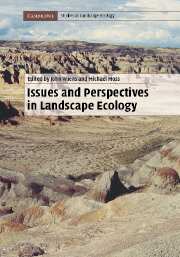Book contents
- Frontmatter
- Contents
- List of contributors
- Preface
- PART I Introductory perspectives
- PART II Theory, experiments, and models in landscape ecology
- PART III Landscape patterns
- PART IV Landscape dynamics on multiple scales
- 14 Landscape sensitivity and timescales of landscape change
- 15 The time dimension in landscape ecology: cultural soils and spatial pattern in early landscapes
- 16 The legacy of landscape history: the role of paleoecological analysis
- 17 Landscape ecology and global change
- PART V Applications of landscape ecology
- PART VI Cultural perspectives and landscape planning
- PART VII Retrospect and prospect
- Index
- Plate section
- References
14 - Landscape sensitivity and timescales of landscape change
from PART IV - Landscape dynamics on multiple scales
Published online by Cambridge University Press: 20 November 2009
- Frontmatter
- Contents
- List of contributors
- Preface
- PART I Introductory perspectives
- PART II Theory, experiments, and models in landscape ecology
- PART III Landscape patterns
- PART IV Landscape dynamics on multiple scales
- 14 Landscape sensitivity and timescales of landscape change
- 15 The time dimension in landscape ecology: cultural soils and spatial pattern in early landscapes
- 16 The legacy of landscape history: the role of paleoecological analysis
- 17 Landscape ecology and global change
- PART V Applications of landscape ecology
- PART VI Cultural perspectives and landscape planning
- PART VII Retrospect and prospect
- Index
- Plate section
- References
Summary
Ideas concerning what is now usually termed “landscape sensitivity” have been a part of geomorphological thinking for half a century, illustrated by the concepts of biostasie and rhexistasie formulated by Erhart (1955) to describe the switch from biogeochemical equilibrium and chemical sedimentation to conditions of erosion and clastic sedimentation. However, the term was first used explicitly by Brunsden and Thornes (1979) to assist understanding of episodes of accelerated erosion and sedimentation as they affect the natural landscape. Although widely employed, the concept has received less attention than might have been expected, and was not widely reviewed until D. Thomas and Allison (1993) brought together a series of papers to show the impacts of environment and land-use changes on landscapes. More recently, another symposium has reviewed the concept and its applications (M. Thomas and Simpson, 2001).
The notion of sensitivity is related to the concept of erosion thresholds and to other aspects of systems analysis, widely discussed since the publication of papers by Knox (1972), Schumm and Parker (1973), and Schumm (1977, 1979) in the 1970s. But “landscape” is a complex entity that has proved difficult to subject to systems analysis. Most geomorphologists have felt more at home with research into fluvial and hillslope systems, and issues concerning landscape per se have received less attention. Often this has implied a lack of emphasis on the role of the vegetation cover and much greater concern with stream channels than with interfluves and hillslopes.
- Type
- Chapter
- Information
- Issues and Perspectives in Landscape Ecology , pp. 131 - 151Publisher: Cambridge University PressPrint publication year: 2005
References
- 2
- Cited by

